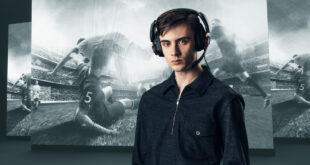John Broomhall talks to Mario Lavin, sound director for Guerrilla Games and guest speaker at the Develop Conference’s audio track…
Mario, we’re delighted to welcome you to this year’s conference. Tell us a bit about yourself.
ML: I’m responsible for the overall direction of everything that comes out of the speakers for Guerilla’s titles.
How do you kick off the process? What design stages are there?
ML: We start by working with concept artists and game designers to get an idea about how the game will play and feel, and what enemies, weapons, vehicles and scenarios there will be. We then do our field recording and ‘concept sound designing,’ which includes vocal processing design, ambient design and musical style definition. During pre-production we design and enhance our integration pipeline and tools.
Killzone 2 is a cinematic sci-fi combat FPS. The soundtrack helps the player become immersed and provides a sonic atmosphere that adapts contextually as they traverse an area – the sound mix and parameters of individual sounds vary.
For example, when transitioning from inside a small building with concrete walls to outside thunderstorms with near-hurricane winds, not only will the ambiences change, but also the guns and explosions. In addition, DSP that affects the sounds will reflect that as accurately as possible by changing parameters – for example, shortening reverb reflection times and the decay of guns and explosions.
We used a lot of DSP and sound modelling techniques. My aim was to create the overwhelming chaos of war but in a cinematic way, making sure the Helghast sounded believable as an enemy. We spent a lot of time designing the voice processing and casting the right voices. I also felt this game needed an intensity-based adaptive music system to further engage the player.
How much was large distance and scale an issue for you?
ML: I wanted to make sure all weapons and explosions had different sounds after a certain distance threshold was crossed, because it helps convey the sense of space a lot better than the same sample just having fall-off via attenuation curves.
How did you approach the sound design for those massive bosses and robots?
ML: Mainly by voice processing and casting, plus huge stomping footsteps to make them sound heavy. For robotic sounds, it took a lot of synthesis and animals combined. Definitely fun!
Was much live recording work done?
ML: Luckily Amsterdam gets great thunderstorms so we could capture a lot of useful ambiences. We recorded guns and weapon foley locally and, for the ISA-Intruder vehicle, we recorded local trains and trams – a very distinct electric whine, later combined with jets and synthesis. The first person player foley was mostly recorded from scratch, too.
And the music?
ML: The game’s composer, Joris De Man, is extremely talented and versatile – he’s also a great sound designer, so understands perfectly how to make music and sound work together. We recorded the score for theme and cinematics at Abbey Road with the Nimrod Session Orchestra. The rest was produced electronically by Joris and mastered at SCEA.
How did you make the adaptive music work?
ML: We would make presets for each level with combat intensities, driven by the number of AI enemies the player was fighting and how fast they are killing them. The music is not always playing; we wanted it to accentuate combat and drive the more emotional moments. Joris made several intensities based on bars/measures and composed loops with reverb tails, so cross-fading transitions sound seamless.
What are your reflections on how music and sound should work together?
ML: It’s give and take. Music can help immensely with the pacing but can also be overkill; if the sound design is emotional, it can deliver the same intended effect that music does. But they should never compete.
Do you have a lot of ‘dynamic’ mixing depending on game states and events?
ML: Our mixer has 192 voices running to 31 sub-mix channels which go to three final mix channels in the user menu. All individual sounds are routed to a sub-mix channel category – i.e. first person weapons, explosions, and the like. The sub-mix is linked to a ‘mixer-zone trigger’ in the game editor, placed in the levels room-by-room and cross-faded dependent on player traversal. We customise volumes for each mix-zone – for example, in a vehicle we turn down explosions and gunfire to hear the vehicles a bit louder. There’s no limit to the number of sub-mixers within a level or section, and they’re previewed and adjusted in real-time during sound implementation.
Are you pleased with the final results?
ML: I’m overall happy with Killzone’s audio – if I had to pick one thing, it would be the guns. I like them loud and dirty! We were fortunate to get a 9/10 critic average so it looks like our hard work paid off.

 MCV/DEVELOP News, events, research and jobs from the games industry
MCV/DEVELOP News, events, research and jobs from the games industry



